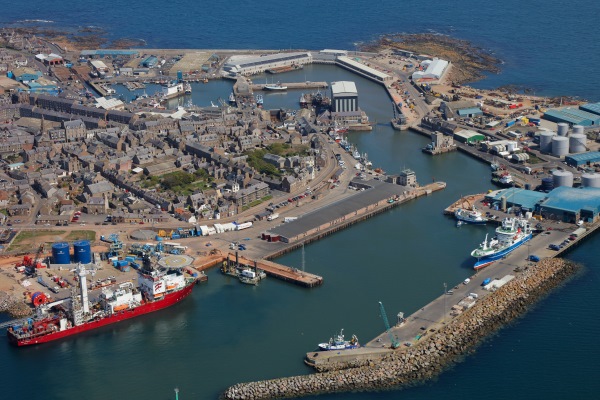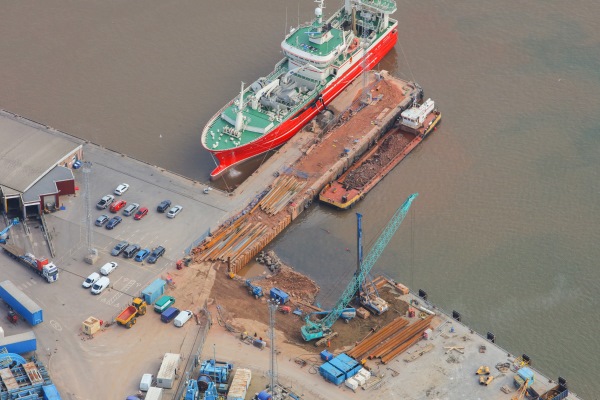Installation of RD pile wall in Peterhead Harbour in Scotland exceeded expectations
There was 14 000 m2 of RD pile wall installed in Peterhead harbor. Total project delivery consisted of 16.5 kilometers of RD piles and there was in total 30 kilometers of SSAB’s RM/RF interlocks welded on the piles. ”Looking back to the project, we can say that the installation exceeded our expectations. Actual drilling to install the piles was much faster than expected. Production was limited more by logistical issues and temporary works required in such a small harbour than the capacity of the system.”, says Stephen McAuley, Contract Manager at McLaughlin & Harvey. The overall redevelopment of the Peterhead harbor has been the largest development project in the history of the Port. Work has commenced in the middle of October 2016 and completed in April 2018.
SSAB’s total project delivery consisted of 1 189 RD piles equal to 16.5 kilometers and 3 200 tons. Original delivery included 960 pieces RD piles 610x12.50 mm in S440J2H in lengths 10.50-16.50 m and 102 pieces RD piles 610x16.00 mm in S440J2H in lengths 15.70 - 20.00 m. There was an additional delivery of 127 pieces of RD piles 610x12.50 mm in S440J2H in length 13.50 m. All RD piles were delivered with SSAB’s RM/RF interlocks. There were in total 30 kilometers of RM/RF interlocks welded on the piles in SSAB’s Oulainen works, where also the piles were produced.
Total project delivery consisted of 16.5 kilometers of RD piles and there was in total 30 kilometers of RM/RF interlocks welded on the piles.
Piling contractor for the project has been Quinn Piling, one of Ireland’s leading geotechnical experts. RD pile wall was installed from old existing quay wall by using DTH with steel fist with wing pilot. Drilling was done in granite rock with an approximate UCS value from 10 - 20 MPa. Installation was executed in both directions; left and right, working simultaneously. Templates were used to secure the wall verticality. RD piles were drilled below 6.5 meters in sea water for 7 meters into existing sea bed. After the installation the existing sea bed will be dredged away for 3 m.
Installation started with 1 rig and increased to 3 rigs working simultaneously. Overall production was planned at 1.5 to 2.5 piles per day. However in some areas installation speed of up to 6 piles per day was achieved. Steel fist with wing pilot needed to be replaced after approximately 50 piles. Some minor corrective actions had to be taken to keep the wall in line by adjusting the RM interlock.
To secure a rigid pile foot all piles are grouted. For the grouting the contractor closed the bottom of the RF interlock and drilled 4 holes in the injection channel in the bottom 2 m. The holes were then plugged with low pressure valves. The contractor used standard grout mix with approximately 20-30 bar pressure.
In September 2016, joint venture partnership between civil engineering contractor McLaughlin & Harvey and dredging contractor Boskalis Westminster was appointed by Peterhead Port Authority for Peterhead Scheme 2. The project entails the strengthening and deepening of the inner harbours, land reclamation with revetment, widening of the harbour entrance and demolition works. In order to allow the harbour floors to be dredged from -3.2 m to -6.5 m CD, the existing quay walls within the Harbour will be strengthened using RD pile wall solution. “We chose the RD pile wall solution because it greatly simplifies the pile installation sequence. The client’s original design required the use of temporary embankments to install reinforced concrete bored piles”, says Stephen McAuley, Contract Manager at McLaughlin & Harvey. He continues “The RD® pile wall solution eliminated the temporary embankments and the piles can be installed in one step to create a continuous wall with only one piling rig”.
Project will enhance Peterhead’s position as Europe’s premier fishing port.
Attachments
Category and tags


